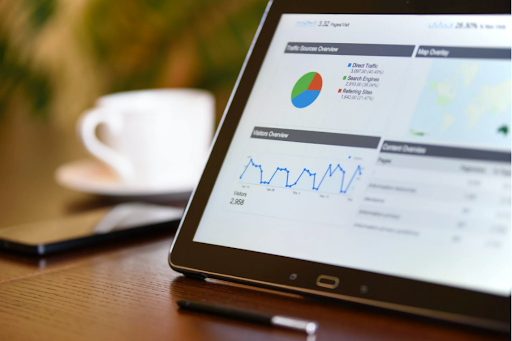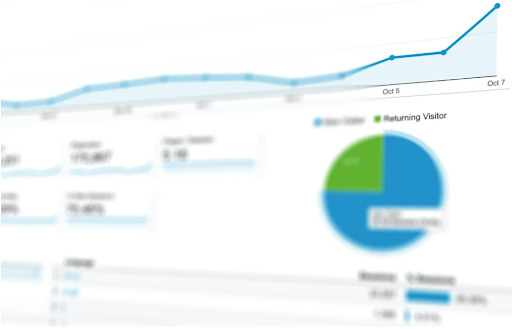There is a great deal of information you can learn from Google Analytics. Many businesses use it to collect, track and analyze data, and then don’t do much of anything with that information. If you don’t analyze your data, then you are missing out on important opportunities to grow your business. This is your guide to getting started with Google Analytics.
How Google Analytics can help your blog
It’s extremely difficult to improve your blog when you don’t even know what is getting viewed, clicked on and what isn’t. In order to grow your traffic, you need to understand your audience and their online behavior. Analytics helps you to gather more than information. Learning Google Analytics from the very beginning may seem like an overwhelming task, but you don’t need to feel this way.
“The best thing you can do is realize that it’s a general-purpose program, and all of the features won’t necessarily be applicable to what you need to do. Once you identify the metrics that matter to you, things will seem much more manageable,” advises Mark Helms, digital strategist at UK Writings.

What exactly is Google Analytics doing?
So what kind of data does Google Analytics actually accumulate? When it’s functioning at its most basic level, the program will collect data on the time of visit, pages viewed, and the amount of time spent there. It will also track details about where the user came from, such as the URI a user came through.
Google Analytics will also track things such as the web browser being used, the operating system being used, IP address, Flash version, Javascript support, and even the screen resolution and screen color processing capability. You can also customize the program to do more advanced data collection such as document downloads, clicks on videos, clicks on links going to external sites, and interactions with site-specific widgets.
Familiarize yourself with the dashboard
“The first thing you will want to do is take a look at the dashboard and learn your way around it. Your main navigation function is on the left side of the screen. You’ll see eight options: dashboards, shortcuts, intelligence events, real-time, audience acquisition, behavior, and conversions,” writes Michael Davis, SEO manager.
The ones you’ll want to focus on at the start are audience, acquisition, and behavior, you can forget about the rest for the time being. Is Google Analytics feeling a bit more approachable now? Hopefully that’s the case. These three options will help you better understand who is visiting your webpage, the path they took to get there, and which specific pages they are spending time on.

Compare your site to industry benchmarks
With Google Analytics, you have at your fingertips data from over 1600 industries to use as benchmarks to compare your business with. The only thing you have to do to get access to this invaluable information is to share your own data. Start by clicking Admin, then under Account, select Account Settings and check the box that says Benchmarking, and hit Save. Go to the left panel and select Audience. Now you can select Benchmarking and pick the kinds of benchmarks you want to see.
Find which pages need optimization and improve them
Check your Google Analytics landing page report to see which pages have problems with their bounce rate, average on-site times, and conversion rates. On the left-hand side, click on Behavior, and then Site Content.
Choose Landing Pages, and then sort them according to bounce rate, average on-site time, and conversion rate. Once you know which pages are having trouble, optimize them by improving keyword relevancy by using similar copy and the same keywords as your AdWords ad. Use tools such as GTMetrix to optimize your page loading speed.

Your audience
Knowing where your visitors are coming from can be very useful, especially if you’re going after a certain geographical region. Think about how much of a difference it would make if you researched and found out that the majority of your readers were located outside North America. Would it change the way you write and the way you advertise? To find out, navigate to Audience, then Geo, then Location. You’ll probably find City and Country to be the most useful categories of information here, but there are others you can check out.
How are my users accessing my site?
Do you know what kinds of devices people are using to access your website? Google recently announced that more people are searching on mobile devices than on desktops. Hopefully, your site works well for mobile users, because that trend is only going to become more important as time goes on. To find out how people are accessing your site, go to Audience, then Mobile, then Overview. You can even break things down by which devices are being used if you select the Devices section. Use Google’s Mobile-Friendly Test to see how well your page performs on mobile platforms.

What sources are sending me traffic?
To see an overview of what websites are directing traffic to you, go to Acquisition, All Traffic, and then Channels. You’ll see a list of different categories of web traffic. The first is organic search, meaning someone clicked on a normal search result. Paid search means traffic directed from a Google AdWords campaign.
You can also see a breakdown of what social media sources are sending you people by clicking on Social. Referral is traffic sent to you by a visitor clicking on a link on another website. Direct traffic is when people type your URL into their web browser or follow a bookmark. Often a high amount of direct traffic means you are building a solid base of repeat, committed users.
Conclusion
There is a ton of useful information available on Google Analytics. Whether you’re running a business, or simply trying to increase the traffic on your blog, Google Analytics can help. It can seem like an overwhelming program when you’re first starting, but it can be easily approached if you know what metrics you are interested in.
